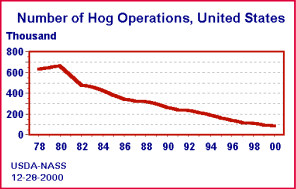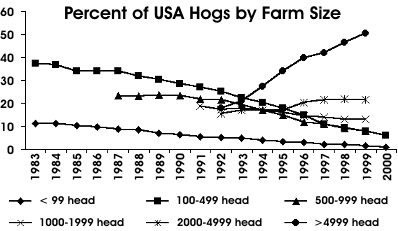Social
and Economic Interactions and the Structure of U.S. Agriculture
 "Consolidation"
and "concentration" are perhaps the most apt words to characterize
the structural change in American agricultural production over the past
two decades. The number of farms with hogs in the United States declined
from almost 700,000 in 1980 to approximately 70,000 in 2000. At the same
time, the percentage of hogs produced by the largest sized farms (greater
than 5,000 head inventory) rose from 20 percent of total U.S. production
in 1992 to approximately 50 percent in 2000. Similar statistics also exist
for poultry and crop production in the U.S. "Consolidation"
and "concentration" are perhaps the most apt words to characterize
the structural change in American agricultural production over the past
two decades. The number of farms with hogs in the United States declined
from almost 700,000 in 1980 to approximately 70,000 in 2000. At the same
time, the percentage of hogs produced by the largest sized farms (greater
than 5,000 head inventory) rose from 20 percent of total U.S. production
in 1992 to approximately 50 percent in 2000. Similar statistics also exist
for poultry and crop production in the U.S.
 This
shift toward larger production units and the substitution of chemical
and mechanical inputs for labor have raised a variety of social and economic
issues. For example, there are questions concerning the environmental
sustainability of modern agricultural production systems. More recently,
low product prices, larger government payments to farmers, and increased
use of alternative business arrangements such as contracting have also
brought into question the economic and social sustainability of the current
agricultural industry structure. This
shift toward larger production units and the substitution of chemical
and mechanical inputs for labor have raised a variety of social and economic
issues. For example, there are questions concerning the environmental
sustainability of modern agricultural production systems. More recently,
low product prices, larger government payments to farmers, and increased
use of alternative business arrangements such as contracting have also
brought into question the economic and social sustainability of the current
agricultural industry structure.
State governments have traditionally promulgated and enforced environmental
policies with respect to farm level production. However, varying political
forces across state lines have led to different degrees of regulation
and enforcement. There is anecdotal evidence suggesting that such differences
are responsible for shifts in livestock production to non-traditional
areas (and less regulated) with less stringent regulation and often where
there is little or no crop base to utilize the manure nutrients. Such
shifts in economic activity may have social and environmental consequences
that are not always in society's best interest.
 Back
to Economics Back
to Economics
|

